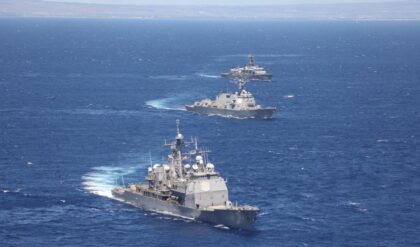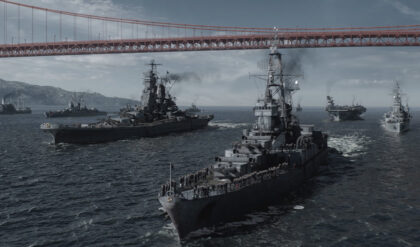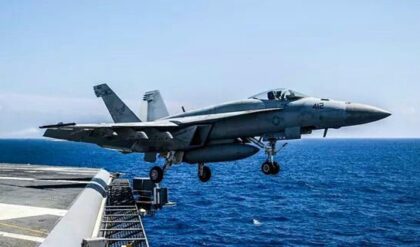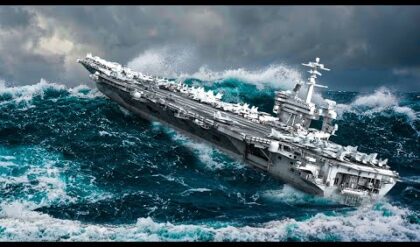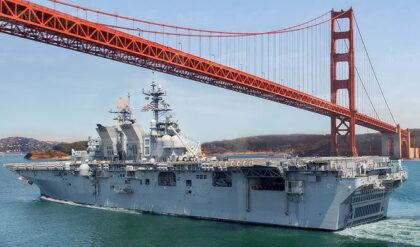In response to the Cold War in the 1960s then General Secretary of the Communist Party of the Soviet Union, Nikita Khrushchev, commissioned a new and unusual type of plane, although some called it a boat.

The International Maritime Organization classifies them as ships. In fact, they were a new hybrid aircraft called ekranoplans.
They skimmed over the water about three to sixteen feet using ground effect, a combination of speed and airflow that allows the heavy craft to fly close to the ground virtually unseen by radar. What was so unusual was the size of these crafts.
The monster machines had short stubby wings with a wing span of just over one hundred and forty four feet.
The maximum speed clocked in at just over three hundred and ten miles per hour. They could carry three hundred passengers; six hundred in an emergency.
 A Cold War top-secret Soviet project. Credit: Lana Sator
A Cold War top-secret Soviet project. Credit: Lana Sator
The main power came from eight NK-87 engines or six PS-90A engines. They could also have been powered by six Rolls Royce engines.
The optical electronic system was a 2100 and on the ship Rescuer was intended for use in search and rescue for those lost at sea and accidents on aircraft, ships, and offshore oil rigs.
The ships were Lun class and included the Rescuer and the Caspian Sea Monster, the nickname for the Korabl Maket or KM. It included eight Kuznetsov NK turbo fans in order to produce thrust.
Unlike the Rescuer she was equipped with P-270 Moskit guided missiles with six missile launchers mounted on the fuselage and had tracking systems in the tail and nose.
 The collapse of the Soviet Union brought an end to the Lun program. It sat for many years in a naval dock.
The collapse of the Soviet Union brought an end to the Lun program. It sat for many years in a naval dock.
The MD-160 was launched by the Russian Navy in 1987 and retired by the end of the 1990s. She could carry a capacity of two hundred and twenty thousand pounds including trucks, tanks and personnel.
She had a crew of six officers and nine enlisted men. She sat deteriorating at a naval base near the Caspian Sea for over thirty years until 2020 when she was towed away from the naval base. The original plan was to tow her to Derbent, Dagestan on the Caspian Sea in southern Russia.
 The cockpit of the ekranoplan. Credit: Lana Sator
The cockpit of the ekranoplan. Credit: Lana Sator
A theme park and museum called Patriot Park is planned but unfortunately the ship got stuck just off the beach on a sandbar. They attempted to free her using tugboats and rubber pontoons but she wouldn’t budge.
She sat rocking in the waves until seawater began to seep into the hull and attracted so much attention from the public she was towed onto dry land about one hundred feet from the shore in December of 2021.
According to cnn.com, a Russian newspaper pointed to the summer of 2022 for an opening date and in April over five million dollars was allocated for the park.
 Lana Sator who took the rare images. Credit: Lana Sator
Lana Sator who took the rare images. Credit: Lana Sator
In 1975 designing and building the fleet of crafts was overseen by Rostislav Evgenievich Alexeyev, the Russian Soviet Director and Chief of Design who had been working on hydrofoil ships and other ground effect vehicles.
Sadly, the fleet Alexeyev had spent so many years working for never materialized. Only the Caspian Monster was completed and the Rescuer, the intended hospital ship, was abruptly stopped when Khrushchev was ousted in 1964 and was succeeded by Leonid Brezhnev who had no interest in building the biggest and best new inventions.
Funding for the project began to slow down until the fall of the Soviet Union in 1991 when it was shut down altogether and Alexeyev was gradually demoted.
You can follow Lana on Instagram Facebook
A very brave photographer, Lana Sater was able to sneak into the ekranoplan in August of 2021 as part of Youtube video from Analysis TV.
